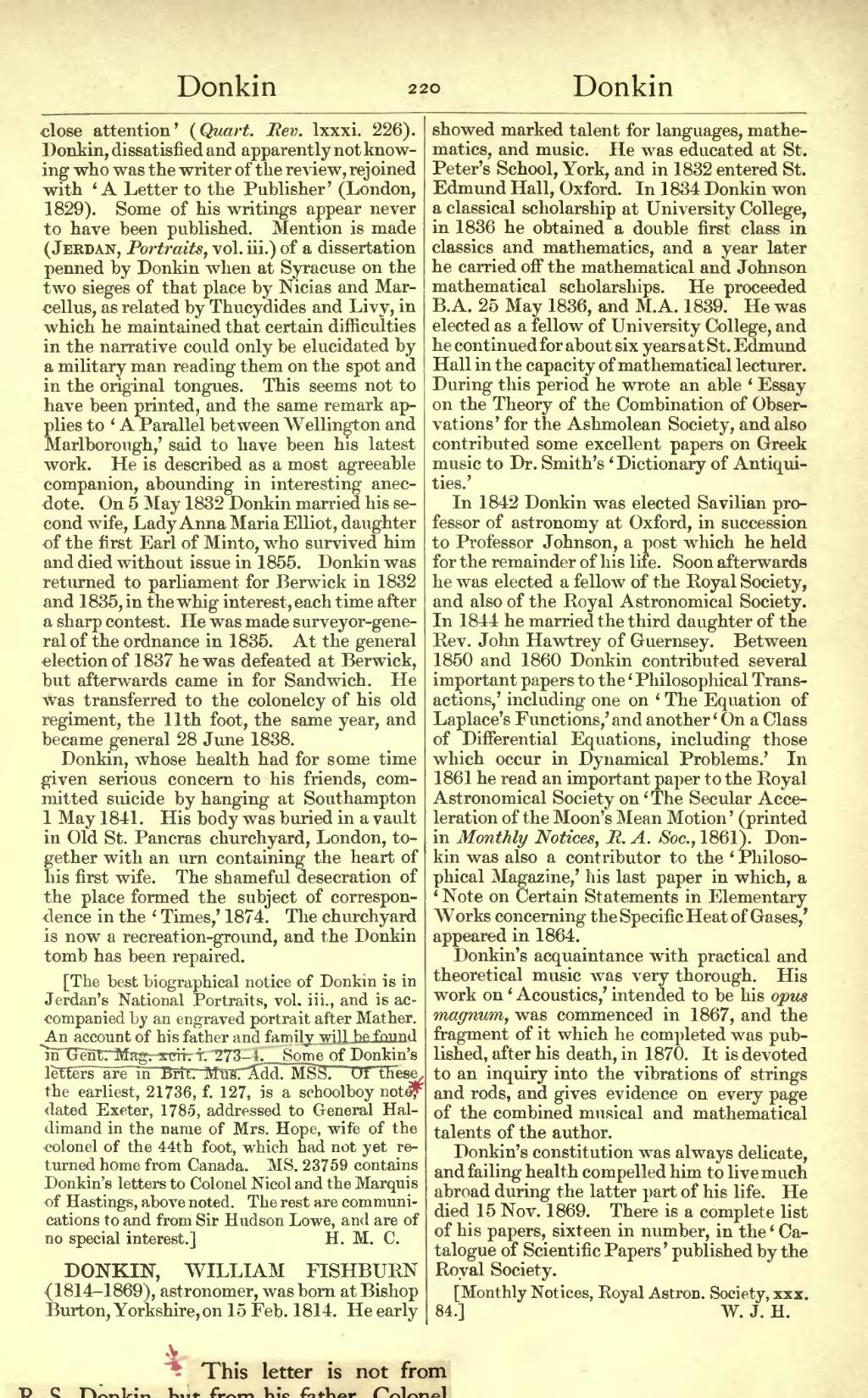close attention’ (Quart. Rev. lxxxi. 226). Donkin, dissatisfied and apparently not knowing who was the writer of the review, rejoined with ‘A Letter to the Publisher’ (London, 1829). Some of his writings appear never to have been published. Mention is made (Jerdan, Portraits, vol. iii.) of a dissertation penned by Donkin when at Syracuse on the two sieges of that place by Nicias and Marcellus, as related by Thucydides and Livy, in which he maintained that certain difficulties in the narrative could only be elucidated by a military man reading them on the spot and in the original tongues. This seems not to have been printed, and the same remark applies to ‘A Parallel between Wellington and Marlborough,’ said to have been his latest work. He is described as a most agreeable companion, abounding in interesting anecdote. On 5 May 1832 Donkin married his second wife, Lady Anna Maria Elliot, daughter of the first Earl of Minto, who survived him and died without issue in 1855. Donkin was returned to parliament for Berwick in 1832 and 1835, in the whig interest, each time after a sharp contest. He was made surveyor-general of the ordnance in 1835. At the general election of 1837 he was defeated at Berwick, but in afterwards came in for Sandwich. He was transferred to the colonelcy of his old regiment, the 11th foot, the same year, and became general 28 June 1838.
Donkin, whose health had for some time given serious concern to his friends, committed suicide by hanging at Southampton 1 May 1841. His body was buried in a vault in Old St. Pancras churchyard, London, together with an urn containing the heart of his first wife. The shameful desecration of the place formed the subject of correspondence in the ‘Times,’ 1874. The churchyard is now a recreation-ground, and the Donkin tomb has been repaired.
[The best biographical notice of Donkin is in Jerdan's National Portraits, vol. iii., and is accompanied by an engraved portrait after Mather. An account of his father and family will be found in Gent. Mag. xcii. i. 273–4. Some of Donkin's letters are in Brit. Mus. Add. MSS. Of these the earliest, 21736, f. 127, is a schoolboy note, dated Exeter, 1785, addressed to General Haldimand in the name of Mrs. Hope, wife of the colonel of the 44th foot, which had not yet returned home from Canada. MS. 23759 contains Donkin's letters to Colonel Nicol and the Marquis of Hastings, above noted. The rest are communications to and from Sir Hudson Lowe, and are of no special interest.]
DONKIN, WILLIAM FISHBURN (1814–1869), astronomer, was born at Bishop Burton, Yorkshire, on 15 Feb. 1814. He early showed marked talent for languages, mathematics, and music. He was educated at St. Peter's School, York, and in 1832 entered St. Edmund Hall, Oxford. In 1834 Donkin won a classical scholarship at University College, in 1836 he obtained a double first class in classics and mathematics, and a year later he carried off the mathematical and Johnson mathematical scholarships. He proceeded B.A. 25 May 1836, and M.A. 1839. He was elected as a fellow of University College, and he continued for about six years at St. Edmund Hall in the capacity of mathematical lecturer. During this period he wrote an able ‘Essay on the Theory of the Combination of Observations’ for the Ashmolean Society, and also contributed some excellent papers on Greek music to Dr. Smith's ‘Dictionary of Antiquities.’
In 1842 Donkin was elected Savilian professor of astronomy at Oxford, in succession to Professor Johnson, a post which he held for the remainder of his life. Soon afterwards he was elected a fellow of the Royal Society, and also of the Royal Astronomical Society. In 1844 he married the third daughter of the Rev. John Hawtrey of Guernsey. Between 1850 and 1860 Donkin contributed several important papers to the ‘Philosophical Transactions,’ including one on ‘The Equation of Laplace's Functions,’ and another ‘On a Class of Differential Equations, including those which occur in Dynamical Problems.’ In 1861 he read an important paper to the Royal Astronomical Society on ‘The Secular Acceleration of the Moon's Mean Motion’ (printed in Monthly Notices, R. A. Soc., 1861). Donkin was also a contributor to the ‘Philosophical Magazine,’ his last paper in which, a ‘Note on Certain Statements in Elementary Works concerning the Specific Heat of Gases’ appeared in 1864.
Donkin's acquaintance with practical and theoretical music was very thorough. His work on ‘Acoustics,’ intended to be his opus magnum, was commenced in 1867, and the fragment of it which he completed was published, after his death, in 1870. It is devoted to an inquiry into the vibrations of strings and rods, and gives evidence on every page of the combined musical and mathematical talents of the author.
Donkin's constitution was always delicate, and failing health compelled him to live much abroad during the latter part of his life. He died 15 Nov. 1869. There is a complete list of his papers, sixteen in number, in the ‘Catalogue of Scientific Papers’ published by the Royal Society.
[Monthly Notices, Royal Astron. Society, xxx. 84.]
